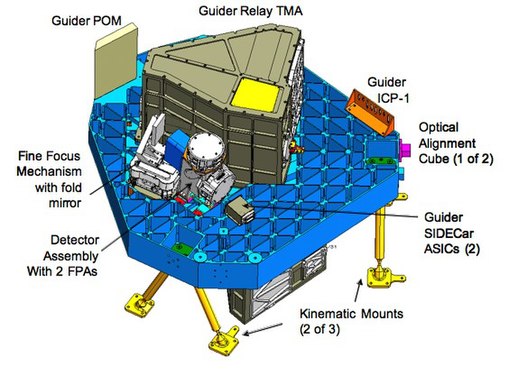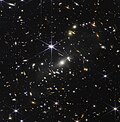


Fine Guidance Sensor and Near Infrared Imager and Slitless Spectrograph (FGS-NIRISS) is an instrument on the James Webb Space Telescope (JWST) that combines a Fine Guidance Sensor and a science instrument, a near-infrared imager and a spectrograph. [1] The FGS/NIRISS was designed by the Canadian Space Agency (CSA) and built by Honeywell [2] as part of an international project to build a large infrared space telescope with the National Aeronautics and Space Administration (NASA) and the European Space Agency (ESA). [1] FGS-NIRISS observes light from the wavelengths of 0.8 to 5.0 microns. [1] The instrument has four different observing modes. [3]
Contents
Physically the FGS and NIRISS are combined, but optically they are separate with the FGS being used by the telescope to point it, whereas NIRISS is an independent science instrument. [3] [4] The spectroscopic mode is capable of doing exoplanet spectroscopy. [5] The detector for NIRISS is a 2048 × 2048 pixel mercury cadmium telluride (HgCdTe) array, where each pixel is 18 microns on a side according to the STSCi. [6] The field of view is 2.2' × 2.2' which gives a plate scale of about 0.065 arcsec/pixel. [6]
The FGS will help the telescope aim and stay pointed at whatever it is commanded to look at. [7] FGS helps provide data to the JWST Attitude Control System (ACS) and to do this it has a big sky coverage and sensitivity, to give a high probability it can find a guide star. [8]
NIRISS is designed for performing: [9] [10]
- Near-infrared imaging
- Wide-field slitless spectroscopy
- Single object slitless spectroscopy
- Aperture masking interferometry
The aperture masking interferometry mode uses a seven-hole aperture masking disc, and should allow the detection of exoplanets within certain ranges of light and types of stars. [9]
The Engineering Test Unit of the FGS was delivered to NASA in 2010. [11] The flight units were planned to be delivered later after the ETU, which enabled testing with other JWST hardware. [11] The flight units of FGS/NIRISS were delivered to NASA in August 2012. [12]
Commissioning is complete as of the following dates:
- Single object slitless spectroscopy, 06/22/2022
- Wide field slitless spectroscopy, 06/14/2022
- Aperture masking interferometry, 06/14/2022
- Imaging (parallel only), 06/08/2022





